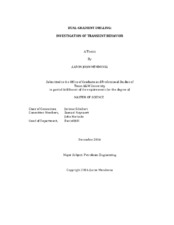| dc.description.abstract | As the industry seeks out exploration prospects in increasing water depths, the complexity of drilling in tight pore-pressure and fracture-pressure windows has become progressively more challenging. Conventional or single-gradient drilling has reached a physical limitation where the formation can no longer tolerate the hydrostatic pressure from a single column of drilling fluid. Narrow pressure windows require additional casing strings, which, when used with conventional drilling technology, complicates reaching geological targets.
There are numerous methods of dual-gradient drilling (DGD) – a subset of managed pressure drilling (MPD) – but each share the same principal. In each method, DGD seeks to eliminate the problems associated with water depth, as DGD closely matches the natural pressure gradient of the water depth. Dual-gradient refers to the ability to adjust two distinct fluid densities by controlling the annular pressure. Therefore, we can manage the effect of equivalent circulating density (ECD) in an effort to maintain bottomhole pressure (BHP) within a narrow operating window between pore pressure and fracture pressure. Therefore, DGD permits longer hole sections and less casing strings in comparison to conventional technology. In a sense, DGD allows development of wells that were at one time considered “un-drillable”.
We will focus on Statoil’s Controlled Mud Pressure field trial using Enhanced Drilling’s DGD technology (EC-Drill™) in the Troll field on the Norwegian Continental Shelf. The EC-Drill™ system is comprised of a subsea pump module (SPM) attached to a marine riser that pumps returns to a discrete mud return line. This system relies on a partially evacuated riser made up of a blanket fluid of air and heavier drilling mud. The riser mud level can be influenced by adjusting the discharge pump rate of the SPM, that when run in automatic mode, the system will maintain constant bottomhole pressure. In contrast, the SPM can be operated in manual mode where a constant riser fluid level is maintained instead –termed ‘controlled mud level’ (CML).
The objective of this research study was to perform simulation on transient behavior during a connection break using Schlumberger software, Drillbench™. Connections made during conventional drilling are potentially precarious times to encounter well kicks due to the loss of annular friction, effectively reducing the BHP down to a static mud weight. In contrast, this research aims to highlight the efficacy of the EC-Drill™ system where the SPM remains circulating during connections, addressing both the U-tubing and loss of annular frictional pressure loss. The simulation software presented an in-depth understanding of the dynamic hydraulics with the capability of reproducing field trials with a level of accuracy that is not obtainable with other competitive steady-state models.
Results demonstrate that constant BHP can be simulated within a +/- 50-psi window, while responding to changes in drilling parameters and navigating tight formation/fracture gradient windows with a full-riser margin. This research required close collaboration with three primary partners – Statoil ASA®, AGR Enhanced Drilling®, and Schlumberger Ltd®. | en |


